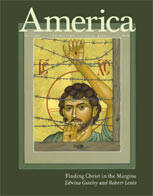This book, Christ in the Margins, took shape on a red plastic tablecloth in a diner in Albuquerque, New Mexico. This is where I met the artist Robert Lentz. The two of us spent hours sharing ideas to bring his vision to reality. Perhaps as we sat together, eyes shining, words tumbling, arms gesticulating, those around us who threw curious glances might well have imagined we were lovers. Indeed we were. We were in love with the Christ we knew danced on the margins of the world, and we were recognizing and naming those who danced with him--Saints Francis and Clare, Steven Biko, Mychal Judge, Elizabeth Cady Stanton, Albert Einstein, Black Elk, Julian of Norwich, Johann Sebastian Bach--and many more. As we spoke of these friends of God we were filled with excitement and joy and we knew that, however long it took, this book must be painted and must be written and must be shared.
For it is time. It is time for all of us who follow Christ to recognize him and to proclaim him. It is time to be prophetic about the Christ we know is present in the folks who are pushed aside, dismissed, left out, undermined, underfed, unhoused, or simply unseen and unheard. It is time to hear the truth in the words of the poet Gerard Manley Hopkins:
For Christ plays in ten thousand places,
Lovely in limbs, lovely in eyes not his,
through the features of [our] faces.
It is time for the people of God to stop marching along with the status quo in search of security, power, and control, but to stumble instead towards the margins where we will encounter a magic and a mystery that will plunge us trembling but rejoicing into the Realm of God. This is what our book is all about. And it invites all of us into such a time and such a place where we will recognize the face of Christ always new, always unexpected. Always reminding us of God’s promise:
I will pour out my Spirit on all humanity;
your sons and daughters shall prophesy,
your old ones shall dream dreams,
and your young shall see visions.
On all men and women
will I pour out my Spirit in those days.
--Joel 2:28-29
In such a time indeed, and only in such a time, along with all God’s prophets, fools, artists, mystics, poets, and children will we realize a new Jerusalem. The invitation is always there. God is always waiting. It is never too late to see, and to become, "Christ in the Margins."
For a PDF version of this article with pictures, click here.









These Just reflect a deeper dimension of God's all embracing love-which includes all of humnanity,and dare I say all of creation.
May Gately's and Lenz's reflections bring us to a deeper appreciation of Emmanuel-God with us.
To us, icons are venerated at a level equal to the Gospel. Icons depict the Gospel in living color, and they cannot be brought up to date any more than the life and times of Jesus Christ. The image of Christ imprisoned within barbed wire, for example, reduces the actual life of Christ to myth; the message is important, the actuality is less so.
Even icons of saints are intended to demonstrate the internalization of the Gospel, the conversion of a man or a woman into the very image and likeness of Christ himself. This is not something that is open to individual interpretation. Rather, it is something that derives its origin from the tradition of the church and the consensus of all of the faithful. While, for example, Albert Einstein and Johann Sebastian Bach may have been very great people, they are not subjects for icons, since they have not been proclaimed saints, transformed into the image and likeness of Christ, by the church.
Iconographic themes are very highly regulated by the tradition of the church. They are not open to the artist’s individual interpretation. In fact, there is no room for individual expression. A true iconographer submits herself in humility and obedience. A true iconographer fears trivialization or misrepresentation. Perfection is the goal; approximation is an abomination.
Such perversion of iconography reduces it to a Western conception of sacred art. In the West, art is thought of as stimulating, interesting or even alarming, but never essential. Icons however, in our Eastern tradition, are what they depict. They actually share in the divine reality of that which is portrayed. In turn, they themselves are transforming and allow the viewer also to participate in this divinization process. Thus they are fundamental to our worship. They are fundamental to life itself.
These Just reflect a deeper dimension of God's all embracing love-which includes all of humnanity,and dare I say all of creation.
May Gately's and Lenz's reflections bring us to a deeper appreciation of Emmanuel-God with us.